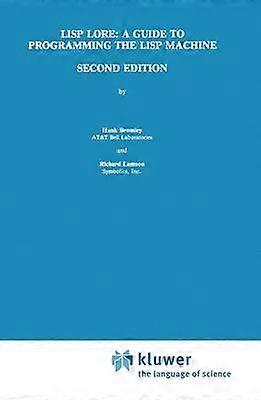Beschreibung
1. Introduction. - 2. Getting Started on the Lisp Machine. - 2. 1 Why Use a Lisp Machine?. - 2. 2 The Keyboard. - 2. 3 Typing to a Lisp Listener. - 2. 4 Getting Around the Environment. - 2. 5 The Mouse. - 2. 5. 1 The System Menu. - 2. 6 The Monitor. - 2. 7 The Editor. - 2. 8 The Compiler and the Debugger. - 2. 9 Getting Started. - 2. 10 A Word About Work Style. - 2. 11 This and That. - 2. 12 Problem Set
1. - 3. Flow of Control. - 3. 1 Conditionals. - 3. 2 Blocks and Exits. - 3. 3 Nonlocal Exits. - 3. 4 Iteration. - 3. 5 Lexical Scoping. - 3. 6 Macros. - 3. 7 Unwind-protect. - 3. 8 Fun and Games. - 3. 9 Problem Set. - 4. More on Navigating the Lisp Machine. - 4. 1 The Scheduler and Processes. - 4. 2 Windows. - 4. 3 Debugging. - 4. 4 The Input Editor and Histories. - 4. 5 Mouse Sensitivity. - 4. 6 Poking Around. - 4. 7 Fun and Games. - 4. 8 Problem Set. - 5. What's a Flavor?. - 5. 1 Instance Variables. - 5. 2 Methods. - 5. 3 Making Instances. - 5. 4 Initial Values for Instance Variables. - 5. 5 Methods for Make-instance. - 5. 6 Mixing Flavors. - 5. 7 Combined Methods. - 5. 8 Whoppers. - 5. 9 Internal Interfaces. - 5. 10 Vanilla Flavor. - 5. 11 The Flavor Examiner Tools. - 5. 12 Message Passing. - 5. 13 The Window System. - 5. 14 Fun and Games. - 5. 15 Problem Set. - 6. User Interface. - 6. 1 Program Frameworks: an Overview. - 6. 2 Defining Commands. - 6. 3 The Redisplay. - 6. 4 Presentation Types. - 6. 5 Mouse Sensitivity. - 6. 6 Fun and Games. - 7. The Graph Example. - 7. 1 The Nodes and Arcs. - 7. 2 The Presentation Types. - 7. 3 The Display. - 7. 4 The Commands. - 7. 5 The Mouse Gesture Translators. - 7. 6 The Program. - 7. 7 Problem Set. - 8. Streams and Files. - 8. 1 Streams. - 8. 2 Accessing Files and Directories. - 8. 3 Pathnames. - 8. 4 Making Other I/O Streams. - 8. 5 Fun and Games. - 8. 6 Problem Set. - 9. The Calculator Example. - 9. 1 The Program Frame. - 9. 2 The Redisplay. - 9. 3 TheCommand-definition Macrology. - 9. 4 The Program. - 9. 5 Fun and Games. - 10. Systems Storage and Errors. - 10. 1 Systems. - 10. 2 Storage Allocation. - 10. 3 Condition Handling. - 10. 4 Fun and Games. - 11. The Card Game Example. - 11. 1 Card Definitions. - 11. 2 Presentation Types. - 11. 3 Card Places. - 11. 4 The Interactive Program. - 11. 5 The Program. - 11. 6 Problem Set. - 11. 7 Fun and Games. - 12. More Advanced Use of the Editor. - 12. 1 Keyboard Macros. - 12. 2 Writing New Commands. - 12. 3 Learning More About the Editor. - 12. 4 Fun and Games. - 12. 5 Problem Set. - 13. A Quick Look At the Network. - 13. 1 The Gee-whiz Look. - 13. 2 The Generic Network System. - 13. 3 The Namespace System. - 13. 4 Examples of the Use of the Generic Network System. - 13. 5 Writing Your Own Network Software. - APPENDIX A. Basic Zmacs Commands. Language: English
-
Fruugo-ID:
337902403-741561762
-
ISBN:
9781461291893
Lieferung und Rückgaben
Versand innerhalb von 4 Tagen
Versand von Vereinigtes Königreich.
Wir tun unser Bestes, um dafür zu sorgen, dass die von Ihnen bestellten Produkte vollständig und gemäß Ihrer Spezifikationen an Sie geliefert werden. Wenn Sie allerdings eine unvollständige Bestellung oder Artikel erhalten, die sich von den bestellten unterscheiden, oder es einen anderen Grund gibt, warum Sie mit Ihrer Bestellung nicht zufrieden sind, können Sie die gesamte Bestellung oder einzelne darin enthaltenen Produkte zurücksenden und eine vollständige Rückerstattung für die Artikel erhalten. Vollständige Rückgaberichtlinie ansehen

